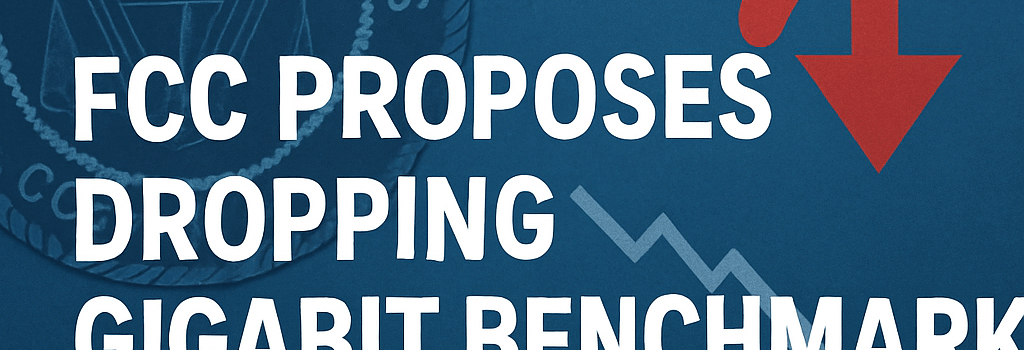FCC Proposes Dropping Gigabit Benchmark and Price Analysis

On July 21, 2025, the Federal Communications Commission (FCC) unveiled a sweeping proposal from Chairman Brendan Carr to overhaul how the agency measures broadband deployment and affordability. The plan would remove the long-term goal of 1 Gbps download/500 Mbps upload speeds, eliminate broadband price and adoption metrics, and shift the Section 706 inquiry toward monitoring ongoing deployment rather than existing coverage.
Section 706 and the “Is Being Deployed” Standard
Section 706 of the Telecommunications Act mandates that the FCC assess whether broadband is being deployed “on a reasonable and timely basis.” If it is not, the commission must act to remove barriers and promote competition. Historically, Democratic-led FCCs have found broadband deployment insufficient and periodically raised speed benchmarks, while Republican-led FCCs have generally concluded that deployment is adequate and maintained lower thresholds.
Carr’s proposal (scheduled for an August 7 vote) argues that the 2024 report’s binary 100% coverage standard misreads the act’s use of the present progressive tense. By focusing on whether deployment is happening, the FCC would measure deployment velocity—for example, new fiber route miles per quarter or fixed wireless access (FWA) cell site rollouts—rather than issuing pass/fail grades based on current coverage.
“Our approach will provide Congress and the public with granular data on build-out rates, permitting trends, and spectrum utilization, rather than simplistic coverage percentages,” Carr wrote.
Scrapping Broadband Affordability and Adoption Metrics
The 2024 report introduced granular affordability and adoption criteria, including price per megabit, low-income subscription rates, and digital literacy. Carr’s draft order deems these metrics “extraneous,” arguing that terms like “affordability” and “adoption” do not appear in Section 706.
Industry experts warn that removing price analysis could hinder efforts to monitor digital equity. Broadband economist Dr. Mei Lin (University of Texas) notes, “Without standardized price data—such as median monthly subscription costs and effective cost per Mbps in rural versus urban areas—policymakers lose visibility into where subsidies or regulatory interventions are most needed.”
Elimination of the Gigabit Speed Goal
Under former Chairwoman Jessica Rosenworcel, the FCC had adopted a long-term goal of 1 Gbps/500 Mbps to guide infrastructure grants and reflect evolving consumer needs. Supporting technologies include:
- Passive Optical Network (PON) standards like XGS-PON and NG-PON2, capable of 10 Gbps downstream.
- DOCSIS 3.1 and emerging DOCSIS 4.0 upgrades for hybrid fiber-coax networks.
- Fixed Wireless Access leveraging 5G mmWave bands to deliver multi-hundred-Mbps speeds.
Carr argues that maintaining a gigabit target “risks picking technological winners and losers,” particularly disadvantaging satellite providers (e.g., Starlink) and 5G FWA operators that currently top out around 200–300 Mbps under ideal conditions.
Impact on Rural and Underserved Communities
Rural areas often rely on a mix of legacy DSL, fixed wireless, and satellite to fill last-mile gaps. The Biden administration’s Broadband Equity, Access, and Deployment (BEAD) program has funneled $42 billion toward primarily fiber builds. By removing a clear fiber-centric speed goal, critics warn that ISPs may reallocate BEAD funds to lower-capacity solutions, potentially leaving thousands of households below the FCC’s 100 Mbps/20 Mbps benchmark.
Potential Implications for Infrastructure Investment and Competition
Carr’s “Delete, Delete, Delete” initiative may spur rollback of regulations deemed outdated. The proposal requests public comment on barriers to investment, including:
- Right-of-way and pole-attachment fee reform for fiber and small-cell deployment.
- Streamlining environmental reviews for microwave and millimeter-wave towers.
- Reevaluating universal service fund contributions and disbursements.
Proponents of deregulation, such as the NCTA – The Internet & Television Association, applaud the move, while advocacy groups like Free Press decry the loss of price transparency and long-term vision.
Next Steps and Industry Reaction
The FCC will accept comments on the proposal until September 15. A final vote is expected in Q4 2025. Meanwhile, ISPs are closely monitoring the outcome, as it may reshape eligibility for federal grants and affect capital expenditure on gigabit-capable networks.